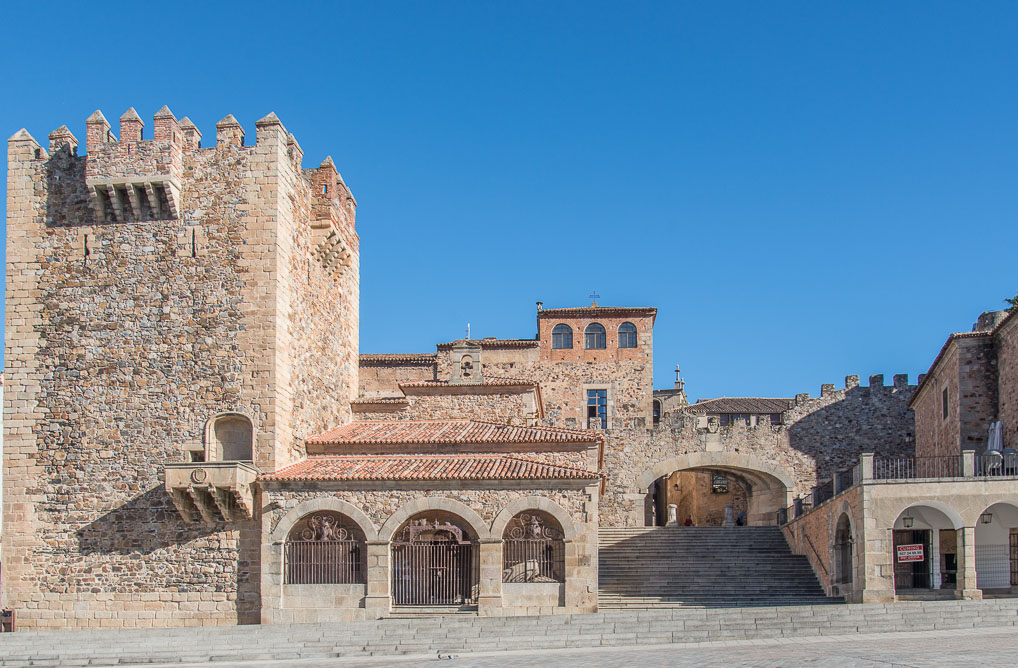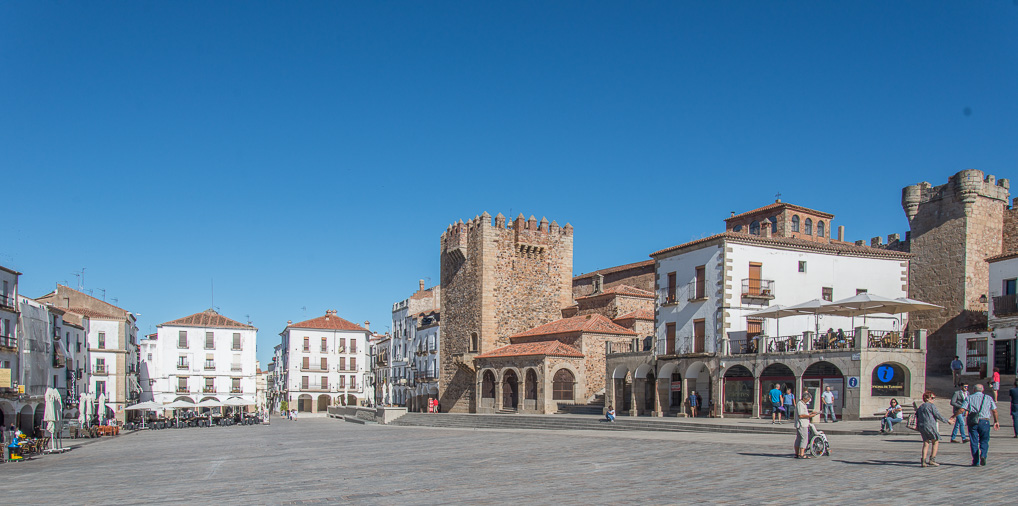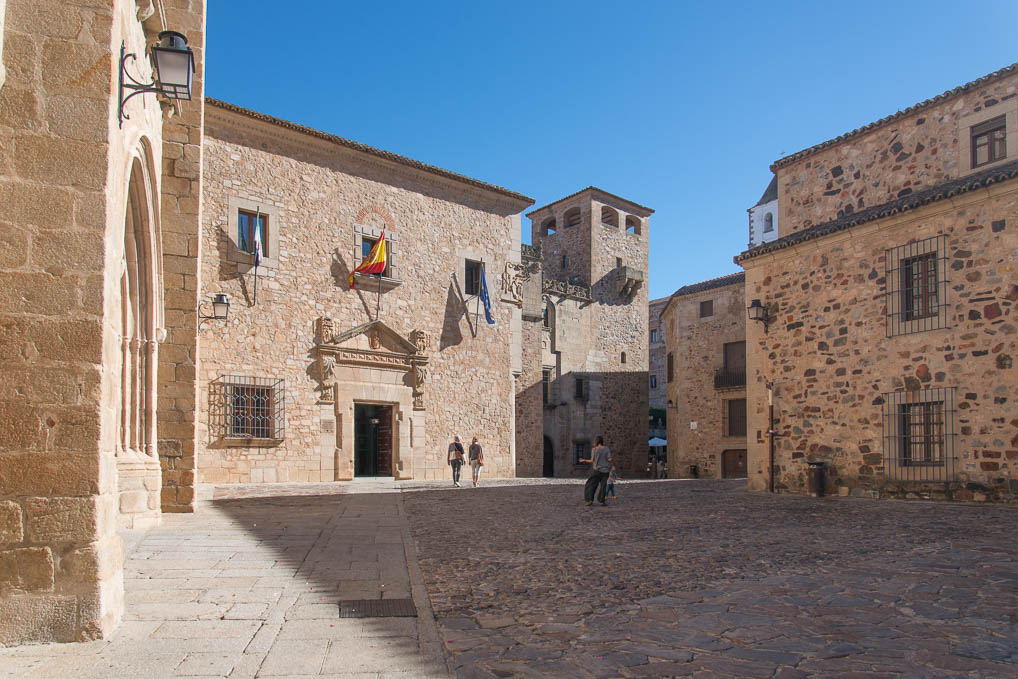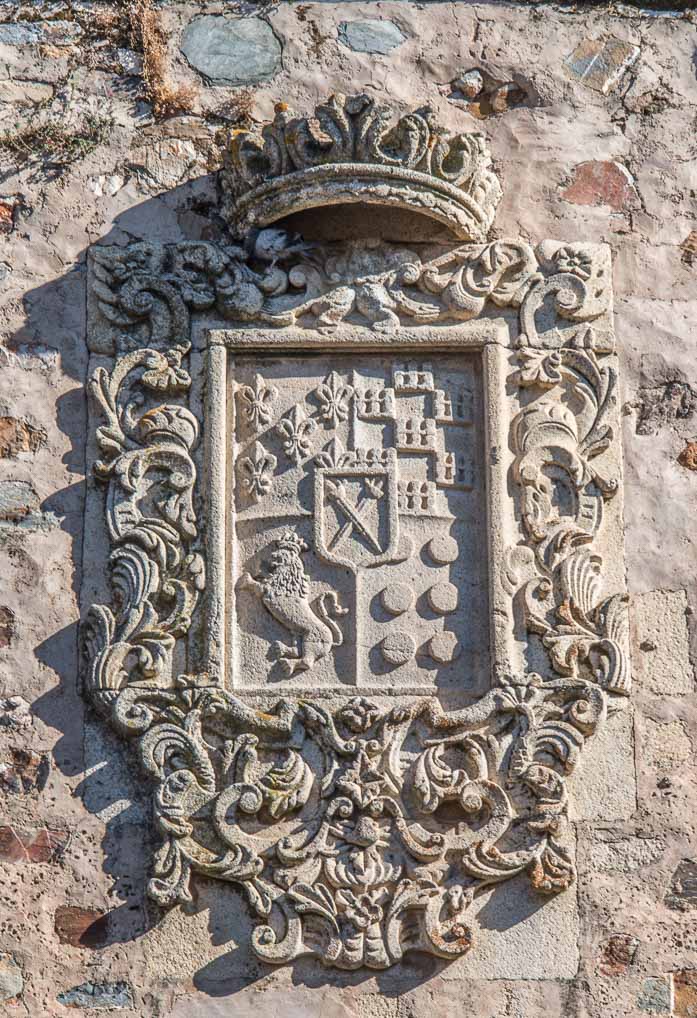Yesterday, while we were waiting in our aire in Caceres for siesta to finish we had a slightly unsettling experience with a large Spanish motorhome trying to squeeze into a space next to enough that was clearly not big enough. I opened our door to get out and try to communicate this with the driver only to find he was so close I couldn’t get the door fully open and he appeared to be continuing to reverse towards Basil. In my desperation I squeezed myself round the door and rapped hard and repeatedly on the side of his van and this seemed to do the trick. As he was pulling away I could see he had no reversing camera and his passenger was not helping to direct him. I can only think they had just arrived from a particularly enjoyable Menu del Dia! They then proceeded to park in another space which had plenty of room. Not speaking Spanish I will never find out what he was trying to do.
At 4pm we set off into Caceres, which is a UNESCO World Heritage site. Our first stop was at the Tourist Information centre which was supposed to be open at 4.30pm, only to find a melee of people outside trying the door and looking through the window. It was clearly shut and as we left the old town 2 hours later it was still closed. Considering almost every village in Spain seems to have a tourist information office staffed by, usually two, underworked officials, it was surprising to see Extramadura’s crown jewels without tourist officials. Fortunately a company trying to sell tours was handing out maps of the city and so we used that to guide us.

Caceres

Plaza Major
The old town of Caceres is very like Trujillo, although with a University Caceres old town is surrounded by a much larger new town. It is an almost completely intact walled town, packed with Conquistador’s palaces, churches, convents etc. Unlike Trujillo most of the buildings are of a large monumental nature, with fewer smaller buildings.

Caceres

Caceres
There are no individual buildings of great importance, although you can visit the interior of a palace and church or two. It is really the atmosphere of the whole which makes a great impression and together with Trujillo is the best example of a medieval walled town which we have ever seen. Both towns are well worth including in any itinerary of Spain alongside their better known rivals such as Salamanca, Toledo, Segovia etc.

Door of the day

Caceres
The original plan for tomorrow was to head a further hour or so south to a town called Merida. This said to have the best collection of Roman remains in Spain. But Sarah and I are beginning to feel a little jaded from walking around old towns and so we have decided instead to turn east and head towards the Mediterranean coast for a bit of R&R. Tomorrow is likely to be a long driving day as we head for Aranjeuz just south of Madrid.

Caceres

Escutcheon – my new favourite word
Today has indeed been a long drive of 200 miles from near the Portuguese border to the town of Aranjuez, just south of Madrid. The central Spanish Plains are really barren, dusty and almost desert like at this time of year. As we approached Madrid it was noticeable that arable agriculture increased. Whether this is because the soil is better or being near to a large market makes farming crops more profitable I have no idea.
A couple of observations from our drive, both of an ornithological bent I’m afraid. The first is that whereas in England the bird of prey most commonly seen patrolling roads is the Kestrel, in Spain it’s the Red Kite, which we have seen in great numbers throughout our time in the country. Secondly, when we occasionally saw a tractor ploughing, the birds following the plough, unlike Herring Gulls in Britain, were dozens of Little Egrets; somehow much more pleasing to the eye.
The name of the town of Aranjuez is well known to me from Spain’s greatest guitar work: Rodrigo’s Concerto de Aranjuez. Unfortunately our experiences here will always colour that music for me in future in a slightly negative way.
When we arrived, after weeks in peaceful rural Spain, I was a little shocked by the huge numbers of cars and people, mostly tourists, thronging the narrow streets. Our campsite, Aranjuez Camping (40.041994, -3.599911) is the our most expensive of the trip at €19 per night on the ACSI card and is nothing more than average. Aranjuez’s main claim to fame, according to the Rough Guide, is a Royal Palace which is a poor attempt to replicate Versailles.
Poor replica or not we decided we would have a quick look and set off on a 1 mile walk to the main town. Our route took us through one of the many Royal parks. We had got about half way through the park when an out of breath security guard, in spotless militaristic uniform, ran up to us and informed us dogs were not allowed in the Royal parks. As we exited we could see one of the staff from the museum located near the park entrance, watching our departure carefully. I suspect she had observed us entering the park and alerted security.
We checked the notice board at the entrance and sure enough it did say no dogs, but we hadn’t noticed it because normally parks are places where dogs are allowed. The notice board seemed to be standard for all Royal parks and so we decided to abandon our walk to the second rate Versailles on the basis that we almost certainly not be allowed in the grounds.
The Spanish attitude to our beloved dogs has been one of the few negatives on this trip. The ban from virtually all public transport has restricted us at times and today’s exclusion from Royal parks was a little irksome. However given that in many parts of Spain bulls are still taunted in bullfights and numerous other unpleasant festivals; donkeys are likewise subject to terrible abuse in other festivals; and until 13 years ago in one festival a live goat was thrown, every year, from a village church tower; it is perhaps not surprising that their attitude to dogs is a little different from the rest of Europe. Although you see many pampered pooches on the streets of Spain, anyone who has visited for any length of time, will recognise that commonly dogs seemed to be kept as some kind of guard, sometimes chained up, often free behind railings, spending their days and their nights barking and howling at every passer by. Howling and barking dogs is the sound of the night in many Spanish towns and villages!
